Case Study Analysis: Critical Incident & Ruby's Death in Hospital
VerifiedAdded on 2023/06/11
|7
|1911
|499
Case Study
AI Summary
This case study report examines the critical incident surrounding the death of Ruby, an 80-year-old patient who died from sepsis caused by aspiration pneumonitis after a nasogastric tube was misplaced in her lung. The report details Ruby's medical history, including Alzheimer's dementia, diverticulitis, and a UTI, which were considered contributing factors. The analysis covers the timeline of her hospital admission, nursing observations, and medical interventions, highlighting potential medical negligence in her care. The report evaluates the Harm Score, indicating the severity of the incident and emphasizing the need for thorough documentation and evaluation of patient care to prevent similar incidents. It concludes that a series of oversights and failures in monitoring Ruby's condition ultimately led to her preventable death.
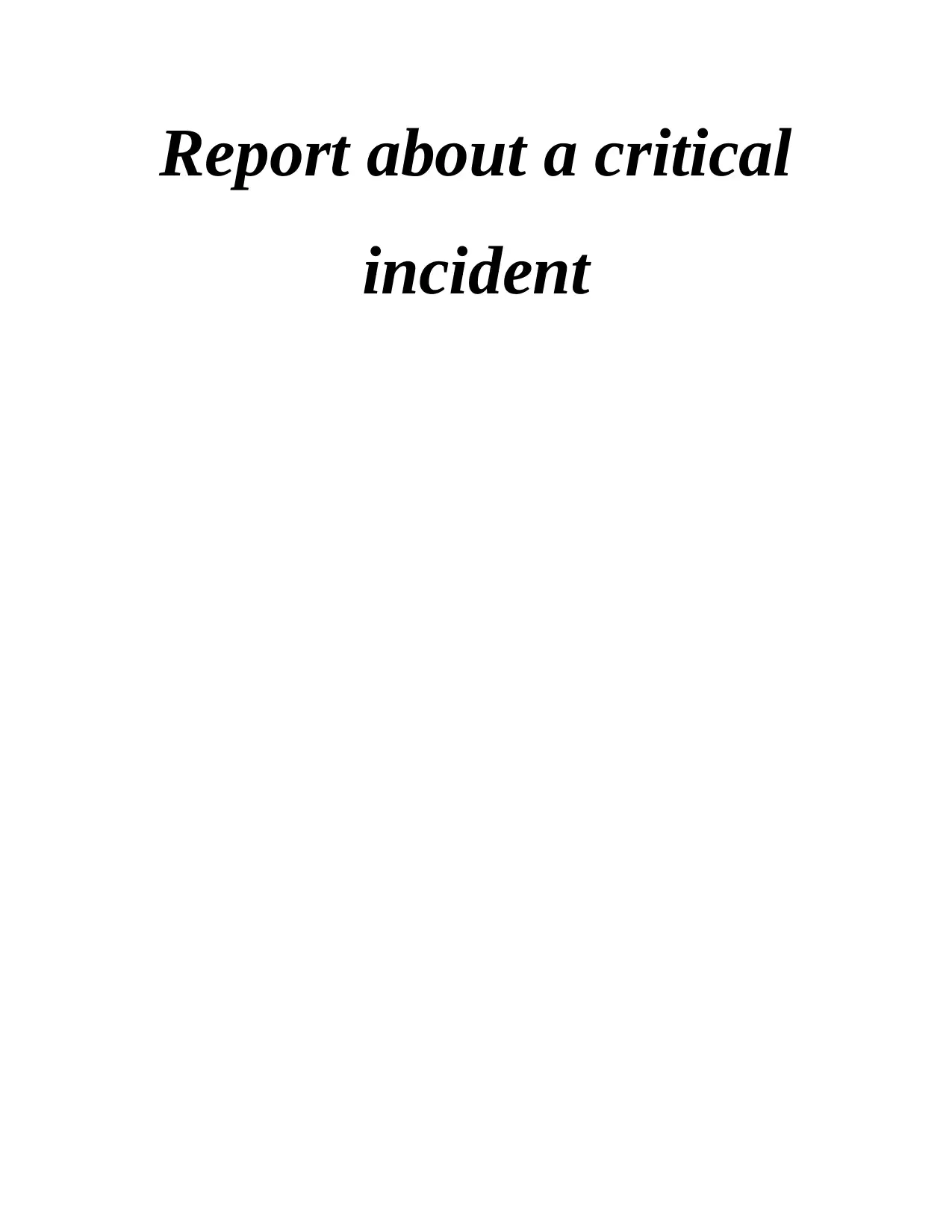
Report about a critical
incident
incident
Paraphrase This Document
Need a fresh take? Get an instant paraphrase of this document with our AI Paraphraser
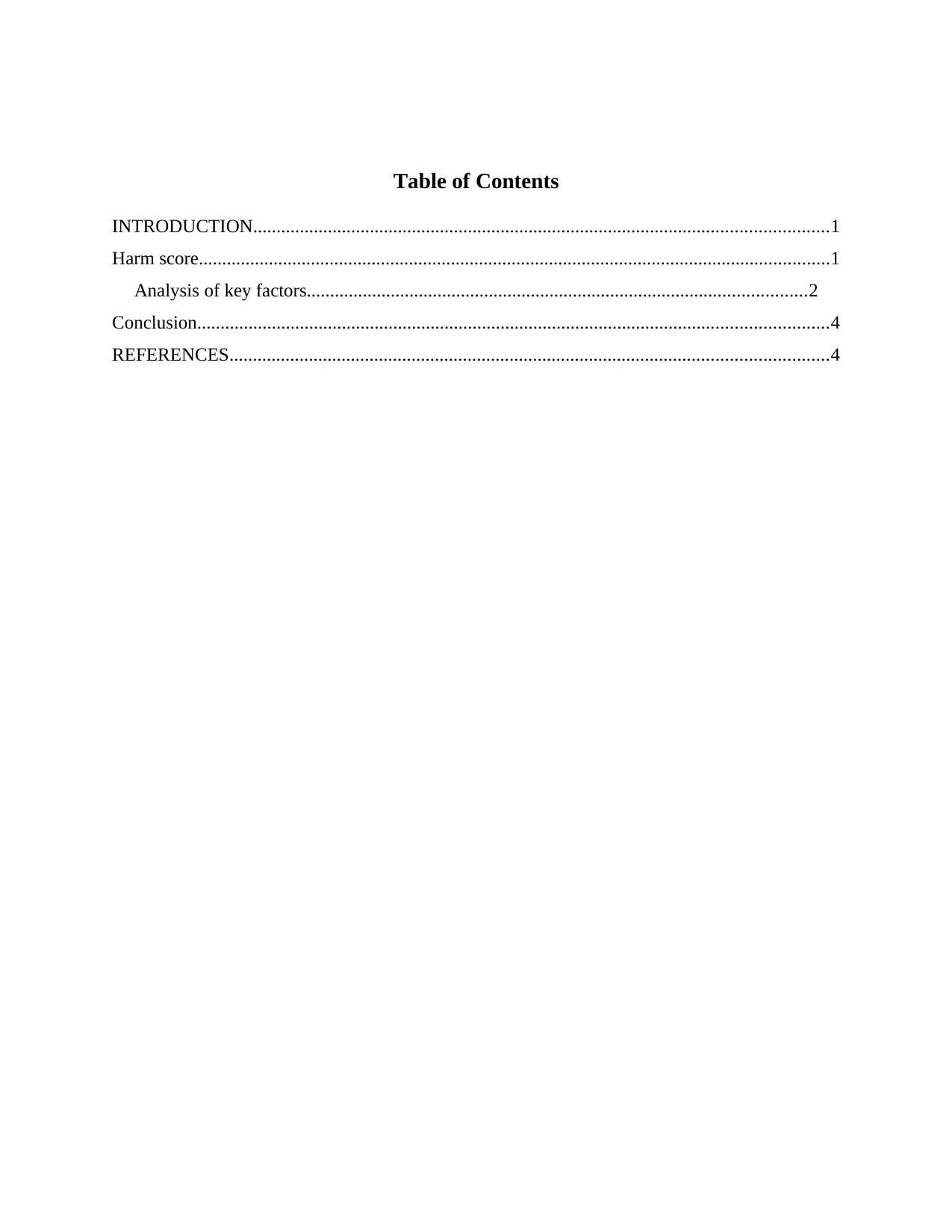
Table of Contents
INTRODUCTION...........................................................................................................................1
Harm score.......................................................................................................................................1
Analysis of key factors...........................................................................................................2
Conclusion.......................................................................................................................................4
REFERENCES................................................................................................................................4
INTRODUCTION...........................................................................................................................1
Harm score.......................................................................................................................................1
Analysis of key factors...........................................................................................................2
Conclusion.......................................................................................................................................4
REFERENCES................................................................................................................................4

INTRODUCTION
A clinical incidence is mainly defined as a event which is having a stressful impact about
a situation which is enough to overwhelm in individual usual coping strategies. In addition to this
it has been underlined that critical incidence are mainly defined as a shocking sudden as well as
outside the range of ordinary human experience (Cleare, Gumley & O'Connor, 2019). In addition
to this it has been identified that any incident in which their effectiveness of the policy responses
furthermore likely to have a significant and their impact on the confidence of victim the
community and the family is defined as a critical incident. There are mainly examples of critical
incidents which is including assault on employee accidents that cause harm or death and etc. In
terms with this report it has been underlined that the case study is discussing is related to Ruby
who was died 1st may in large regional private hospital. She was in her 80s in addition to this
according to the case study. It has been identified that she died from sepsis which is caused by
aspiration as a result of NGT being inserted into her right lung instead of her stomach. Present
report is going to analyse this case study alone with the ham score and analysis of factor
Harm score
Background
Ruby was leading a fulfilling life with her children and her husband she had grandchildren and
great children. She got older and she suffered from Alzheimer’s dementia and cognitive decline.
In addition to this this case study also analyse that she was having the major symptoms of Ruby
were lowered pressure decrease in oral intake and fever. Along with this she was also diagnosed
with a UTA urinary tract infection. In addition to this in terms with nursing intervention it was
been identified that Ruby was also not eating her meals and her blood pressure was extremely
low. This was according to a dietician review after nursing observation Ruby was transferred to
ICU. She also had GORD (gastro-oesophageal reflux disease), hiatus hernia, diverticulitis,
COPD (chronic obstructive pulmonary disease) and Sjogren’s disease, an autoimmune disorder.
1
A clinical incidence is mainly defined as a event which is having a stressful impact about
a situation which is enough to overwhelm in individual usual coping strategies. In addition to this
it has been underlined that critical incidence are mainly defined as a shocking sudden as well as
outside the range of ordinary human experience (Cleare, Gumley & O'Connor, 2019). In addition
to this it has been identified that any incident in which their effectiveness of the policy responses
furthermore likely to have a significant and their impact on the confidence of victim the
community and the family is defined as a critical incident. There are mainly examples of critical
incidents which is including assault on employee accidents that cause harm or death and etc. In
terms with this report it has been underlined that the case study is discussing is related to Ruby
who was died 1st may in large regional private hospital. She was in her 80s in addition to this
according to the case study. It has been identified that she died from sepsis which is caused by
aspiration as a result of NGT being inserted into her right lung instead of her stomach. Present
report is going to analyse this case study alone with the ham score and analysis of factor
Harm score
Background
Ruby was leading a fulfilling life with her children and her husband she had grandchildren and
great children. She got older and she suffered from Alzheimer’s dementia and cognitive decline.
In addition to this this case study also analyse that she was having the major symptoms of Ruby
were lowered pressure decrease in oral intake and fever. Along with this she was also diagnosed
with a UTA urinary tract infection. In addition to this in terms with nursing intervention it was
been identified that Ruby was also not eating her meals and her blood pressure was extremely
low. This was according to a dietician review after nursing observation Ruby was transferred to
ICU. She also had GORD (gastro-oesophageal reflux disease), hiatus hernia, diverticulitis,
COPD (chronic obstructive pulmonary disease) and Sjogren’s disease, an autoimmune disorder.
1
⊘ This is a preview!⊘
Do you want full access?
Subscribe today to unlock all pages.

Trusted by 1+ million students worldwide
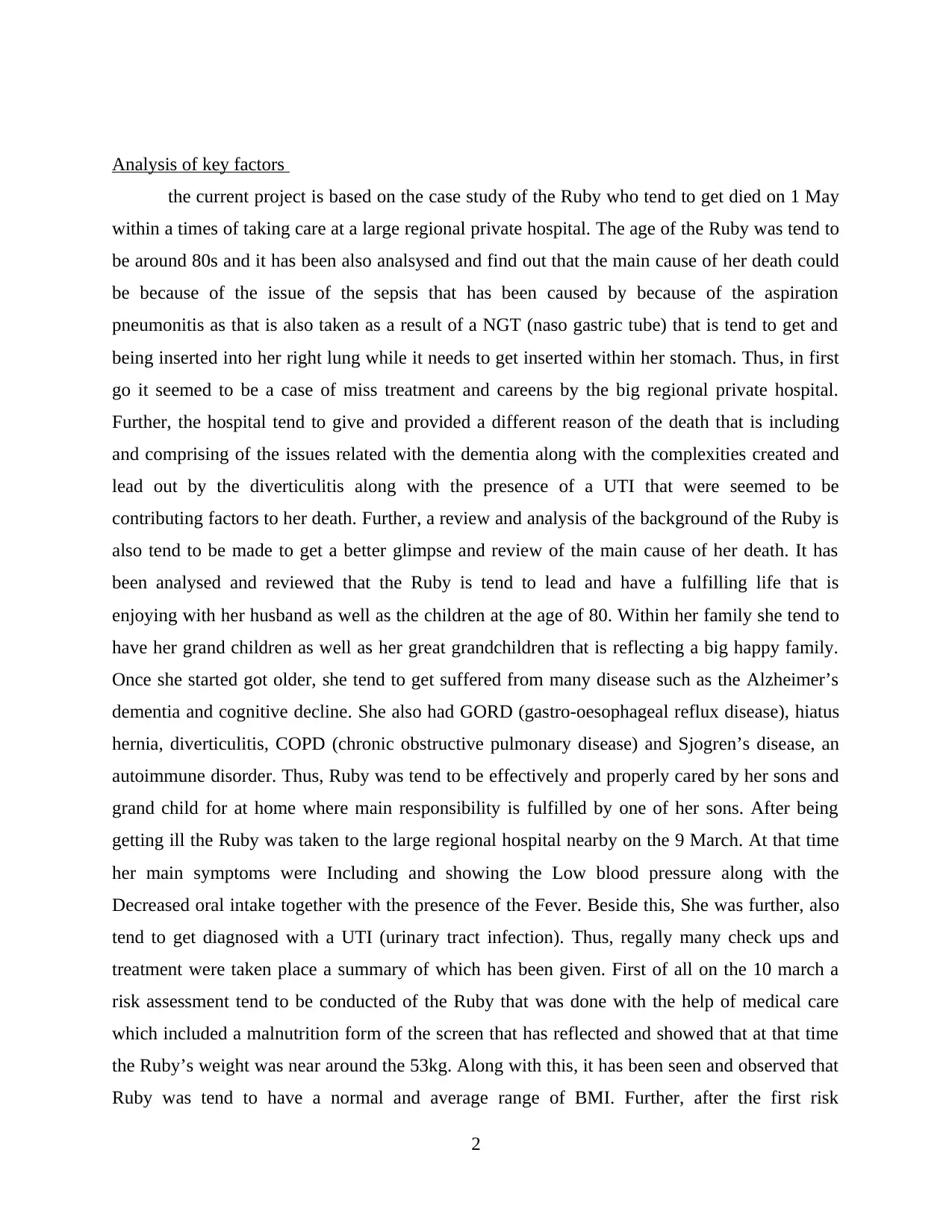
Analysis of key factors
the current project is based on the case study of the Ruby who tend to get died on 1 May
within a times of taking care at a large regional private hospital. The age of the Ruby was tend to
be around 80s and it has been also analsysed and find out that the main cause of her death could
be because of the issue of the sepsis that has been caused by because of the aspiration
pneumonitis as that is also taken as a result of a NGT (naso gastric tube) that is tend to get and
being inserted into her right lung while it needs to get inserted within her stomach. Thus, in first
go it seemed to be a case of miss treatment and careens by the big regional private hospital.
Further, the hospital tend to give and provided a different reason of the death that is including
and comprising of the issues related with the dementia along with the complexities created and
lead out by the diverticulitis along with the presence of a UTI that were seemed to be
contributing factors to her death. Further, a review and analysis of the background of the Ruby is
also tend to be made to get a better glimpse and review of the main cause of her death. It has
been analysed and reviewed that the Ruby is tend to lead and have a fulfilling life that is
enjoying with her husband as well as the children at the age of 80. Within her family she tend to
have her grand children as well as her great grandchildren that is reflecting a big happy family.
Once she started got older, she tend to get suffered from many disease such as the Alzheimer’s
dementia and cognitive decline. She also had GORD (gastro-oesophageal reflux disease), hiatus
hernia, diverticulitis, COPD (chronic obstructive pulmonary disease) and Sjogren’s disease, an
autoimmune disorder. Thus, Ruby was tend to be effectively and properly cared by her sons and
grand child for at home where main responsibility is fulfilled by one of her sons. After being
getting ill the Ruby was taken to the large regional hospital nearby on the 9 March. At that time
her main symptoms were Including and showing the Low blood pressure along with the
Decreased oral intake together with the presence of the Fever. Beside this, She was further, also
tend to get diagnosed with a UTI (urinary tract infection). Thus, regally many check ups and
treatment were taken place a summary of which has been given. First of all on the 10 march a
risk assessment tend to be conducted of the Ruby that was done with the help of medical care
which included a malnutrition form of the screen that has reflected and showed that at that time
the Ruby’s weight was near around the 53kg. Along with this, it has been seen and observed that
Ruby was tend to have a normal and average range of BMI. Further, after the first risk
2
the current project is based on the case study of the Ruby who tend to get died on 1 May
within a times of taking care at a large regional private hospital. The age of the Ruby was tend to
be around 80s and it has been also analsysed and find out that the main cause of her death could
be because of the issue of the sepsis that has been caused by because of the aspiration
pneumonitis as that is also taken as a result of a NGT (naso gastric tube) that is tend to get and
being inserted into her right lung while it needs to get inserted within her stomach. Thus, in first
go it seemed to be a case of miss treatment and careens by the big regional private hospital.
Further, the hospital tend to give and provided a different reason of the death that is including
and comprising of the issues related with the dementia along with the complexities created and
lead out by the diverticulitis along with the presence of a UTI that were seemed to be
contributing factors to her death. Further, a review and analysis of the background of the Ruby is
also tend to be made to get a better glimpse and review of the main cause of her death. It has
been analysed and reviewed that the Ruby is tend to lead and have a fulfilling life that is
enjoying with her husband as well as the children at the age of 80. Within her family she tend to
have her grand children as well as her great grandchildren that is reflecting a big happy family.
Once she started got older, she tend to get suffered from many disease such as the Alzheimer’s
dementia and cognitive decline. She also had GORD (gastro-oesophageal reflux disease), hiatus
hernia, diverticulitis, COPD (chronic obstructive pulmonary disease) and Sjogren’s disease, an
autoimmune disorder. Thus, Ruby was tend to be effectively and properly cared by her sons and
grand child for at home where main responsibility is fulfilled by one of her sons. After being
getting ill the Ruby was taken to the large regional hospital nearby on the 9 March. At that time
her main symptoms were Including and showing the Low blood pressure along with the
Decreased oral intake together with the presence of the Fever. Beside this, She was further, also
tend to get diagnosed with a UTI (urinary tract infection). Thus, regally many check ups and
treatment were taken place a summary of which has been given. First of all on the 10 march a
risk assessment tend to be conducted of the Ruby that was done with the help of medical care
which included a malnutrition form of the screen that has reflected and showed that at that time
the Ruby’s weight was near around the 53kg. Along with this, it has been seen and observed that
Ruby was tend to have a normal and average range of BMI. Further, after the first risk
2
Paraphrase This Document
Need a fresh take? Get an instant paraphrase of this document with our AI Paraphraser
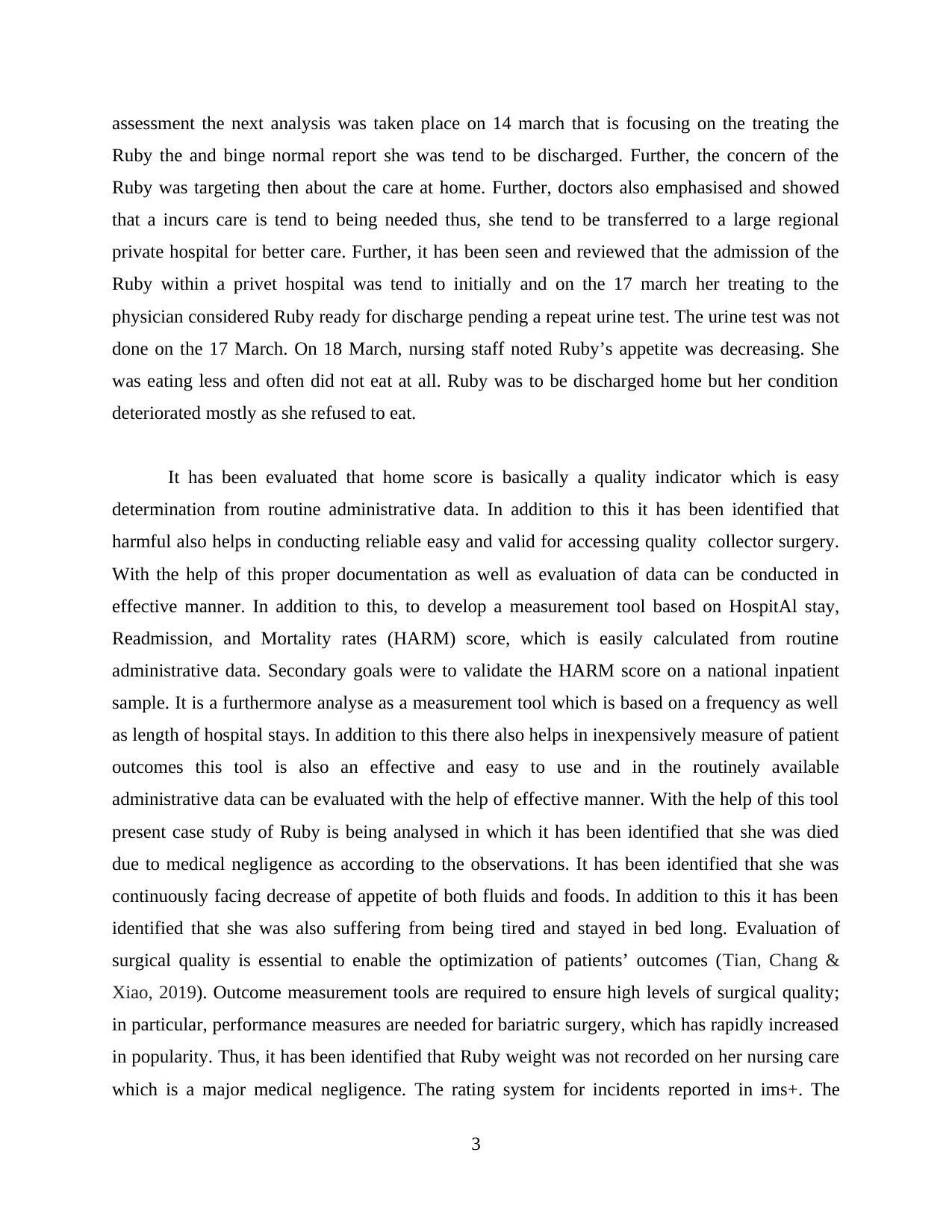
assessment the next analysis was taken place on 14 march that is focusing on the treating the
Ruby the and binge normal report she was tend to be discharged. Further, the concern of the
Ruby was targeting then about the care at home. Further, doctors also emphasised and showed
that a incurs care is tend to being needed thus, she tend to be transferred to a large regional
private hospital for better care. Further, it has been seen and reviewed that the admission of the
Ruby within a privet hospital was tend to initially and on the 17 march her treating to the
physician considered Ruby ready for discharge pending a repeat urine test. The urine test was not
done on the 17 March. On 18 March, nursing staff noted Ruby’s appetite was decreasing. She
was eating less and often did not eat at all. Ruby was to be discharged home but her condition
deteriorated mostly as she refused to eat.
It has been evaluated that home score is basically a quality indicator which is easy
determination from routine administrative data. In addition to this it has been identified that
harmful also helps in conducting reliable easy and valid for accessing quality collector surgery.
With the help of this proper documentation as well as evaluation of data can be conducted in
effective manner. In addition to this, to develop a measurement tool based on HospitAl stay,
Readmission, and Mortality rates (HARM) score, which is easily calculated from routine
administrative data. Secondary goals were to validate the HARM score on a national inpatient
sample. It is a furthermore analyse as a measurement tool which is based on a frequency as well
as length of hospital stays. In addition to this there also helps in inexpensively measure of patient
outcomes this tool is also an effective and easy to use and in the routinely available
administrative data can be evaluated with the help of effective manner. With the help of this tool
present case study of Ruby is being analysed in which it has been identified that she was died
due to medical negligence as according to the observations. It has been identified that she was
continuously facing decrease of appetite of both fluids and foods. In addition to this it has been
identified that she was also suffering from being tired and stayed in bed long. Evaluation of
surgical quality is essential to enable the optimization of patients’ outcomes (Tian, Chang &
Xiao, 2019). Outcome measurement tools are required to ensure high levels of surgical quality;
in particular, performance measures are needed for bariatric surgery, which has rapidly increased
in popularity. Thus, it has been identified that Ruby weight was not recorded on her nursing care
which is a major medical negligence. The rating system for incidents reported in ims+. The
3
Ruby the and binge normal report she was tend to be discharged. Further, the concern of the
Ruby was targeting then about the care at home. Further, doctors also emphasised and showed
that a incurs care is tend to being needed thus, she tend to be transferred to a large regional
private hospital for better care. Further, it has been seen and reviewed that the admission of the
Ruby within a privet hospital was tend to initially and on the 17 march her treating to the
physician considered Ruby ready for discharge pending a repeat urine test. The urine test was not
done on the 17 March. On 18 March, nursing staff noted Ruby’s appetite was decreasing. She
was eating less and often did not eat at all. Ruby was to be discharged home but her condition
deteriorated mostly as she refused to eat.
It has been evaluated that home score is basically a quality indicator which is easy
determination from routine administrative data. In addition to this it has been identified that
harmful also helps in conducting reliable easy and valid for accessing quality collector surgery.
With the help of this proper documentation as well as evaluation of data can be conducted in
effective manner. In addition to this, to develop a measurement tool based on HospitAl stay,
Readmission, and Mortality rates (HARM) score, which is easily calculated from routine
administrative data. Secondary goals were to validate the HARM score on a national inpatient
sample. It is a furthermore analyse as a measurement tool which is based on a frequency as well
as length of hospital stays. In addition to this there also helps in inexpensively measure of patient
outcomes this tool is also an effective and easy to use and in the routinely available
administrative data can be evaluated with the help of effective manner. With the help of this tool
present case study of Ruby is being analysed in which it has been identified that she was died
due to medical negligence as according to the observations. It has been identified that she was
continuously facing decrease of appetite of both fluids and foods. In addition to this it has been
identified that she was also suffering from being tired and stayed in bed long. Evaluation of
surgical quality is essential to enable the optimization of patients’ outcomes (Tian, Chang &
Xiao, 2019). Outcome measurement tools are required to ensure high levels of surgical quality;
in particular, performance measures are needed for bariatric surgery, which has rapidly increased
in popularity. Thus, it has been identified that Ruby weight was not recorded on her nursing care
which is a major medical negligence. The rating system for incidents reported in ims+. The
3
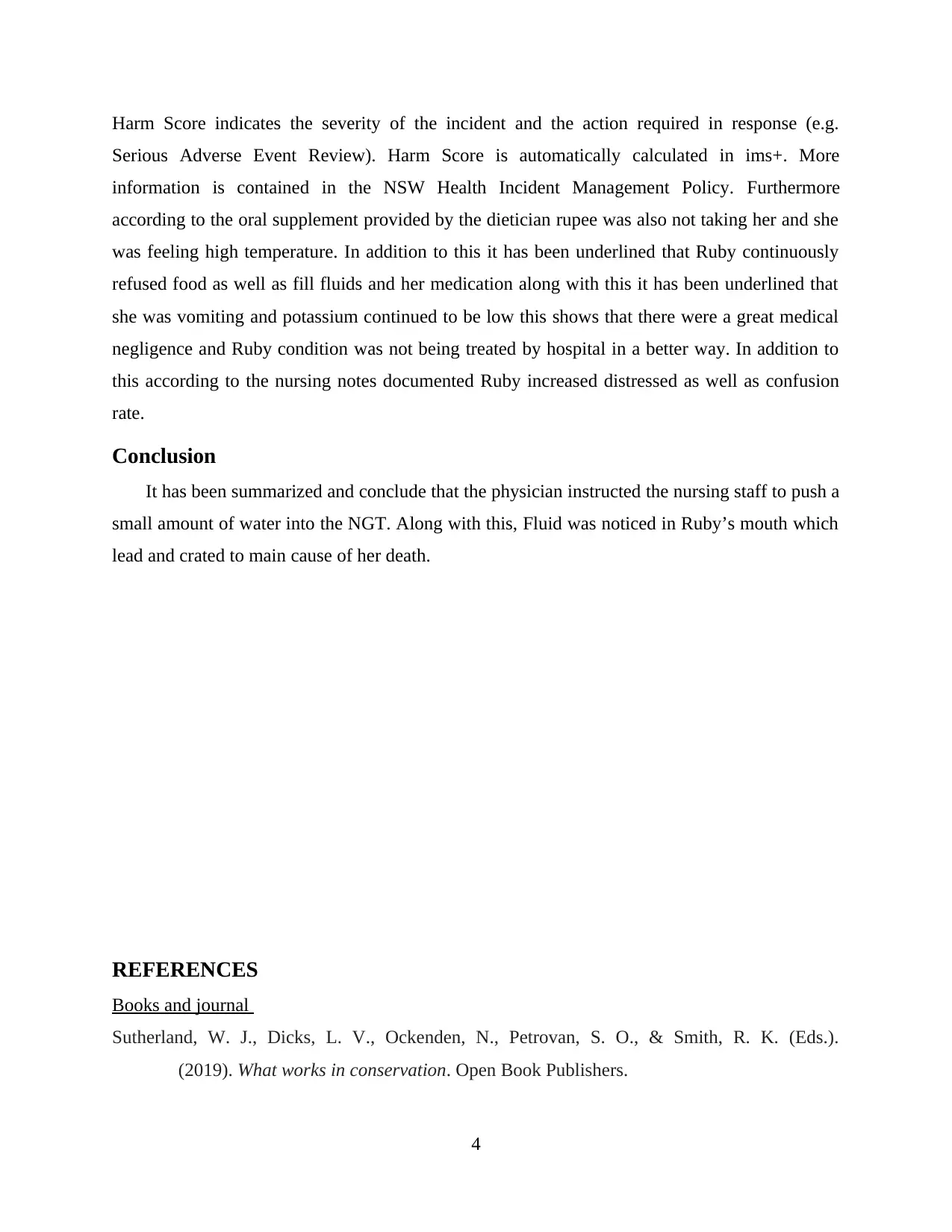
Harm Score indicates the severity of the incident and the action required in response (e.g.
Serious Adverse Event Review). Harm Score is automatically calculated in ims+. More
information is contained in the NSW Health Incident Management Policy. Furthermore
according to the oral supplement provided by the dietician rupee was also not taking her and she
was feeling high temperature. In addition to this it has been underlined that Ruby continuously
refused food as well as fill fluids and her medication along with this it has been underlined that
she was vomiting and potassium continued to be low this shows that there were a great medical
negligence and Ruby condition was not being treated by hospital in a better way. In addition to
this according to the nursing notes documented Ruby increased distressed as well as confusion
rate.
Conclusion
It has been summarized and conclude that the physician instructed the nursing staff to push a
small amount of water into the NGT. Along with this, Fluid was noticed in Ruby’s mouth which
lead and crated to main cause of her death.
REFERENCES
Books and journal
Sutherland, W. J., Dicks, L. V., Ockenden, N., Petrovan, S. O., & Smith, R. K. (Eds.).
(2019). What works in conservation. Open Book Publishers.
4
Serious Adverse Event Review). Harm Score is automatically calculated in ims+. More
information is contained in the NSW Health Incident Management Policy. Furthermore
according to the oral supplement provided by the dietician rupee was also not taking her and she
was feeling high temperature. In addition to this it has been underlined that Ruby continuously
refused food as well as fill fluids and her medication along with this it has been underlined that
she was vomiting and potassium continued to be low this shows that there were a great medical
negligence and Ruby condition was not being treated by hospital in a better way. In addition to
this according to the nursing notes documented Ruby increased distressed as well as confusion
rate.
Conclusion
It has been summarized and conclude that the physician instructed the nursing staff to push a
small amount of water into the NGT. Along with this, Fluid was noticed in Ruby’s mouth which
lead and crated to main cause of her death.
REFERENCES
Books and journal
Sutherland, W. J., Dicks, L. V., Ockenden, N., Petrovan, S. O., & Smith, R. K. (Eds.).
(2019). What works in conservation. Open Book Publishers.
4
⊘ This is a preview!⊘
Do you want full access?
Subscribe today to unlock all pages.

Trusted by 1+ million students worldwide

Tian, X., Chang, W., Meng, Q., Chen, Y., Yu, Z., He, L., & Xiao, Y. (2019). Resilience and self-
harm among left-behind children in Yunnan, China: a community-based survey. BMC
public health, 19(1), 1-8.
Porter, A., Hill, M. A., Harm, R., & Greiwe, R. M. (2021). Resiliency influences postoperative
outcomes following rotator cuff repair. Journal of Shoulder and Elbow Surgery, 30(5),
1181-1185.
Harris, I. M., Beese, S., & Moore, D. (2019). Predicting future self-harm or suicide in
adolescents: a systematic review of risk assessment scales/tools. BMJ open, 9(9),
e029311.
Cleare, S., Gumley, A., & O'Connor, R. C. (2019). Self‐compassion, self‐forgiveness, suicidal
ideation, and self‐harm: A systematic review. Clinical psychology &
psychotherapy, 26(5), 511-530.
5
harm among left-behind children in Yunnan, China: a community-based survey. BMC
public health, 19(1), 1-8.
Porter, A., Hill, M. A., Harm, R., & Greiwe, R. M. (2021). Resiliency influences postoperative
outcomes following rotator cuff repair. Journal of Shoulder and Elbow Surgery, 30(5),
1181-1185.
Harris, I. M., Beese, S., & Moore, D. (2019). Predicting future self-harm or suicide in
adolescents: a systematic review of risk assessment scales/tools. BMJ open, 9(9),
e029311.
Cleare, S., Gumley, A., & O'Connor, R. C. (2019). Self‐compassion, self‐forgiveness, suicidal
ideation, and self‐harm: A systematic review. Clinical psychology &
psychotherapy, 26(5), 511-530.
5
1 out of 7
Your All-in-One AI-Powered Toolkit for Academic Success.
+13062052269
info@desklib.com
Available 24*7 on WhatsApp / Email
![[object Object]](/_next/static/media/star-bottom.7253800d.svg)
Unlock your academic potential
Copyright © 2020–2025 A2Z Services. All Rights Reserved. Developed and managed by ZUCOL.


